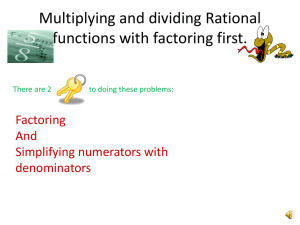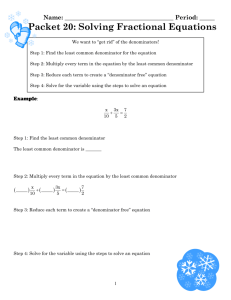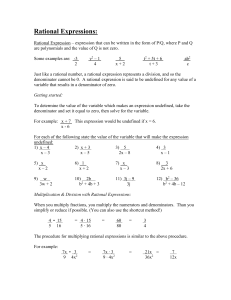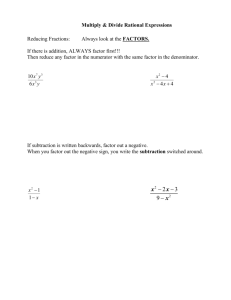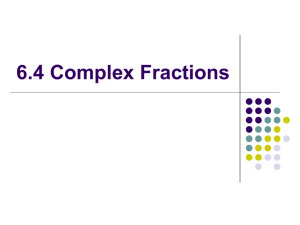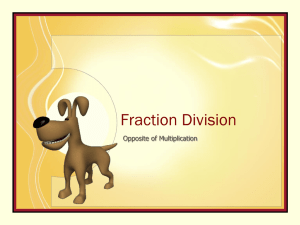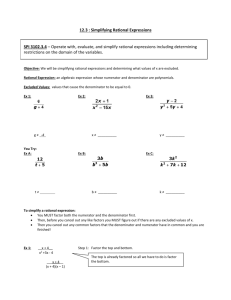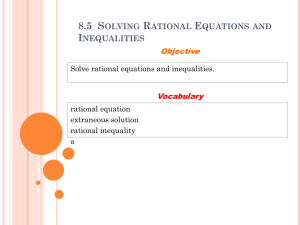chapter 2 examples and explanations
advertisement
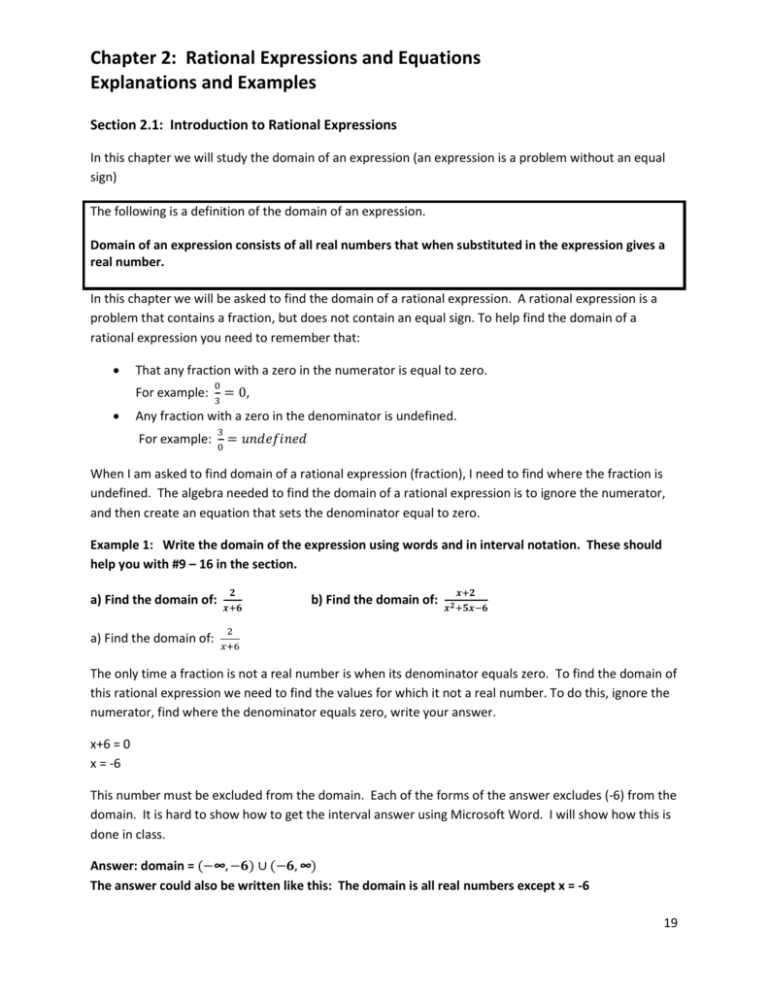
Chapter 2: Rational Expressions and Equations Explanations and Examples Section 2.1: Introduction to Rational Expressions In this chapter we will study the domain of an expression (an expression is a problem without an equal sign) The following is a definition of the domain of an expression. Domain of an expression consists of all real numbers that when substituted in the expression gives a real number. In this chapter we will be asked to find the domain of a rational expression. A rational expression is a problem that contains a fraction, but does not contain an equal sign. To help find the domain of a rational expression you need to remember that: That any fraction with a zero in the numerator is equal to zero. For example: 0 3 = 0, Any fraction with a zero in the denominator is undefined. For example: 3 0 = 𝑢𝑛𝑑𝑒𝑓𝑖𝑛𝑒𝑑 When I am asked to find domain of a rational expression (fraction), I need to find where the fraction is undefined. The algebra needed to find the domain of a rational expression is to ignore the numerator, and then create an equation that sets the denominator equal to zero. Example 1: Write the domain of the expression using words and in interval notation. These should help you with #9 – 16 in the section. a) Find the domain of: 𝟐 𝒙+𝟔 a) Find the domain of: 2 𝑥+6 b) Find the domain of: 𝒙+𝟐 𝒙𝟐 +𝟓𝒙−𝟔 The only time a fraction is not a real number is when its denominator equals zero. To find the domain of this rational expression we need to find the values for which it not a real number. To do this, ignore the numerator, find where the denominator equals zero, write your answer. x+6 = 0 x = -6 This number must be excluded from the domain. Each of the forms of the answer excludes (-6) from the domain. It is hard to show how to get the interval answer using Microsoft Word. I will show how this is done in class. Answer: domain = (−∞, −𝟔) ∪ (−𝟔, ∞) The answer could also be written like this: The domain is all real numbers except x = -6 19 Chapter 2: Rational Expressions and Equations Explanations and Examples Section 2.1: Introduction to Rational Expressions b) Find the domain of: 𝑥+2 𝑥 2 +5𝑥−6 The only time this fraction is not a real number is when its denominator equals zero. To find the domain of this rational expression we need to find the values for which it not a real number. To do this, ignore the numerator, find where the denominator equals zero, then write your answer. x2 + 5x – 6 = 0 (x + 6)(x – 1) = 0 x + 6 = 0 or x – 1 = 0 x = -6 or x = 1 These numbers must be excluded from the domain. Each of the forms of the answer excludes (-6) and 1 from the domain. It is hard to show how to get the interval answer using Microsoft Word. I will show how this is done in class. Answer: domain = (−∞, −𝟔) ∪ (−𝟔, 𝟏) ∪ (𝟏, ∞) The answer could also be written like this: The domain is all real numbers except x = -6, 1 Example 2: Reduce the expression to lowest terms. This should help with #17 – 30. a) 𝟐𝟎𝒂𝟐 𝒃𝟓 𝟏𝟒𝒂𝟔 𝒃 b) 𝒙𝟐 −𝟏𝟔 𝒙𝟐 +𝟑𝒙−𝟒 a) Reduce the expression to lowest terms. 𝟐𝟎𝒂𝟐 𝒃𝟓 𝟏𝟒𝒂𝟔 𝒃 I will treat this as three problems as I reduce the expression. 20 NUMBER PART: The fraction 14 reduces by 2 to: 10 7 a’s: Subtract the exponents on the a’s and leave the a where the larger exponent is. The a will remain in the denominator, because the larger exponent is in the denominator. a6-2 = a4 (in the denominator) b’s: Subtract the exponents of the b’s and leave the b in the numerator, because the larger exponent is in the numerator. b5-1 = b4 (in the numerator) Write your answer. Answer: 𝟏𝟎𝒃𝟒 𝟕𝒂𝟒 20 Chapter 2: Rational Expressions and Equations Explanations and Examples Section 2.1: Introduction to Rational Expressions b) Reduce the expression to lowest terms. 𝒙𝟐 −𝟏𝟔 𝒙𝟐 +𝟑𝒙−𝟒 First factor both the numerator and the denominator: (𝑥+4)(𝑥−4) = (𝑥+4)(𝑥−1) Cancel the (x+4)’s and write your answer. Answer: 𝒙−𝟒 𝒙−𝟏 Example 3: Reduce the expression involving a ratio of (-1). This should help with #39 – 46. a) 𝒙−𝟑 𝟑−𝒙 b) a) Reduce the expression to lowest terms 𝑥− −1(𝑥−3) Cancel the (x-3)’s and you are left with = 𝑥−3 −𝑥+3 Then factor out a (-1) from the denominator. = 𝒙−𝟑 𝟑−𝒙 Rewrite the denominator with the x first = 𝟑𝒙−𝟏𝟐 𝟖−𝟐𝒙 1 −1 Simplify and write your answer. Answer: -1 21 Chapter 2: Rational Expressions and Equations Explanations and Examples Section 2.1: Introduction to Rational Expressions b) Reduce the expression to lowest terms Rewrite the denominator with the (-2x) first. = 𝟑𝒙−𝟏𝟐 𝟖−𝟐𝒙 3𝑥−12 −2𝑥+8 Factor out 3 from the numerator, and (-2) from the denominator. 3(𝑥−4) = −2(𝑥−4) Cancel the (x-4)’s 3 = −2 Write your answer. 𝟑 Answer: − 𝟐 (You can leave the negative in the denominator or write it in the numerator if you like.) 22 Chapter 2: Rational Expressions and Equations Explanations and Examples Section 2.2: Multiplication and Division of Rational Expressions In this section we will by multiplying and dividing rational expressions. For the most part this really means to factor and cancel. STEPS to solve multiplication problems involving rational expressions: STEP 1) Factor all numerators and denominators STEP 2) Reduce any integer coefficients, and cancel any common factors STEP 3) Multiply the remaining factors in the numerator and denominator STEPS to solve division problems involving rational expressions: STEP 1) Change the problem to a multiplication problem by taking the reciprocal of the fraction to the right of the division sign. STEP 2) Factor all numerators and denominators STEP 3) Reduce any integer coefficients, and cancel any common factors STEP 4) Multiply the remaining factors in the numerator and denominator Example 1: Multiply or divide as indicated. These should help with #7-33 in this section. a) 𝟑𝒂 𝟐𝒂+𝟏𝟐 ∙ 𝟓𝒂+𝟑𝟎 𝟏𝟐𝒂𝟐 a) 𝟑𝒂 𝟐𝒂+𝟏𝟐 ∙ 𝟓𝒂+𝟑𝟎 𝟏𝟐𝒂𝟐 b) 𝒑𝟐 +𝟑𝒑+𝟐 𝟒𝒑𝟐 −𝟏 ∙ 𝟐 𝟐 𝟐𝒑 −𝟑𝒑+𝟏 𝟐𝒑 +𝟓𝒑+𝟐 3𝑎 STEP 1) Factor = 5(𝑎+6) ∙ c) 𝒙𝟐 −𝒙−𝟔 ÷ 𝒙𝟐 +𝟑𝒙+𝟐 𝒙𝟐 −𝟕𝒙+𝟏𝟐 𝒙𝟐 +𝟐𝒙−𝟐𝟒 d) 𝒃𝟐 +𝟕𝒃+𝟔 ÷ 𝒃𝟐 −𝟏 (𝒃𝟐 − 𝟑𝟔) 2(𝑎+6) 12𝑎 2 STEP 2) Reduce the 3 in the left numerator with the 12 in the right denominator, and cancel the (a+6)’s cancel the a in the left numerator with the a2 in the right denominator 1 2 = 5 ∙ 4𝑎 now I will cancel the 2 in the right numerator with the 4 in the right denominator 1 1 5 2𝑎 = ∙ STEP 3) Multiply the numerator and denominator. 1 = 10𝑎 Answer: 𝟏 𝟏𝟎𝒂 23 Chapter 2: Rational Expressions and Equations Explanations and Examples Section 2.2: Multiplication and Division of Rational Expressions b) Multiply or divide as indicated. (𝑝+1)(𝑝+2) STEP 1) Factor = (2𝑝−1)(𝑝−1) ∙ 𝑝2 +3𝑝+2 4𝑝2 −1 ∙ 2𝑝2 −3𝑝+1 2𝑝2 +5𝑝+2 (2𝑝+1)(2𝑝−1) (2𝑝+1)(𝑝+2) STEP 2) Reduce (I can cancel identical factors as long as one is in the denominator and the other is in the numerator. The factors can be in the same fraction, or opposite fraction. cancel the (p+2)’s and cancel the (2p-1)’s cancel (2p+1)’s 𝑝+1 1 = 𝑝−1 ∙ 1 STEP 3) Multiply the numerator and denominator. = Answer: c) 𝑝+1 𝑝−1 𝒑+𝟏 𝒑−𝟏 𝑥 2 −𝑥−6 𝑥 2 +3𝑥+2 ÷ 𝑥 2 −7𝑥+12 𝑥 2 +2𝑥−24 𝑥 2 −𝑥−6 𝑥 2 +2𝑥−24 STEP 1) Write as a multiplication problem. = 𝑥 2 +3𝑥+2 ∙ 𝑥 2 −7𝑥+12 (𝑥−3)(𝑥+2) (𝑥+6)(𝑥−4) STEP 2) Factor = (𝑥+1)(𝑥+2) ∙ (𝑥−3)(𝑥−4) 1 STEP 3) Cancel = 𝑥+1 ∙ 𝑥+6 1 𝑥+6 STEP 4) Multiply the numerator and denominator = 𝑥+1 Answer: 𝒙+𝟔 𝒙+𝟏 24 Chapter 2: Rational Expressions and Equations Explanations and Examples Section 2.2: Multiplication and Division of Rational Expressions d) 𝑏2 +7𝑏+6 ÷ 𝑏2 −1 (𝑏 2 − 36) STEP 1) Write as a multiplication problem. = (𝑏+1)(𝑏+6) 𝑏2 +7𝑏+6 1 ∙ 2 𝑏2 −1 𝑏 −36 1 STEP 2) Factor = (𝑏+1)(𝑏−1) ∙ (𝑏+6)(𝑏−6) 1 1 STEP 3) Cancel = 𝑏−1 ∙ 𝑏−6 1 STEP 4) Multiply the numerator and denominator = (𝑏−1)(𝑏−6) = Answer: 1 𝑏2 −6𝑏−1𝑏+6 𝟏 𝒃𝟐 −𝟕𝒃+𝟔 25 Chapter 2: Rational Expressions and Equations Explanations and Examples Section 2.3: Least Common Denominator Example 1: Fill in the blank to convert the expressions to equivalent expressions with the indicated denominator. These should help with #1-12. a) a) 𝟑 𝟓𝒙𝟐 𝒚 = 𝟐𝟎𝒙𝟑𝒚𝟔 3 5𝑥 2 𝑦 b) 𝟓𝒙 𝒙+𝟔 = (𝒙+𝟔)(𝒙−𝟒) = 20𝑥3 𝑦6 I want to make the two fractions equivalent. I will multiply the left fraction by “1” to get my answer. I need to find out what version of “1” I need to multiply by. To do this I divide the right denominator by the left denominator. What version of 1 to multiply by: 20𝑥 3 𝑦 6 5𝑥 2 𝑦 I will multiply the left fraction by 4𝑥𝑦 4 4𝑥𝑦 4 = = 4𝑥𝑦 4 3 4𝑥𝑦 4 ∙ 5𝑥 2 𝑦 4𝑥𝑦 4 DO NOT CANCEL IN THIS SECTION BEFORE YOU MULTIPLY, EVEN THOUGH YOU IT IS POSSIBLE TO CANCEL BEFORE YOU MULTIPLY . CANCELING BEFORE YOU MULTIPLY WILL CAUSE YOU TO GET THE WRONG ANSWER Now I will multiply the numerator and denominators 12𝑥𝑦 4 = 20𝑥3 𝑦6 The problem only asks for the numerator of the right fraction. That is all I will include in my answer. It wouldn’t be wrong to write the entire fraction in your answer. Answer: 12xy4 26 Chapter 2: Rational Expressions and Equations Explanations and Examples Section 2.3: Least Common Denominator b) 5𝑥 𝑥+6 = (𝑥+6)(𝑥−4) I want to make the two fractions equivalent. I will multiply the left fraction by “1” to get my answer. I need to find out what version of “1” I need to multiply by. To do this I divide the right denominator by the left denominator. What version of 1 to multiply by: I will multiply the left fraction by 5𝑥 (x+6)(x−4) x+6 =x−4 𝑥−4 𝑥−4 𝑥−4 = 𝑥+6 ∙ 𝑥−4 DO NOT CANCEL IN THIS SECTION BEFORE YOU MULTIPLY, EVEN THOUGH YOU CAN CANCEL BEFORE YOU MULTIPLY . CANCELING BEFORE YOU MULTIPLY WILL CAUSE YOU TO GET THE WRONG ANSWER Now I will multiply the numerator, in this section we don’t normally FOIL out the denominators when they are binomials. 5𝑥(𝑥−4) 5𝑥 2 −20𝑥 = (𝑥+6)(𝑥−4) = (𝑥+6)(𝑥−4) The problem only asks for the numerator of the right fraction. That is all I will include in my answer. It wouldn’t be wrong to write the entire fraction in your answer. Answer: 5x2 – 20x The next group of problems asks to identify the LCD of two or more rational expressions. Here is a definition of LCD (least common denominator). Least Common Denominator (LCD) is the least common multiple of the denominators. The definition doesn’t really tell you how to find a LCD between fractions. These steps will help you determine the LCD. These steps will make more sense when you finish working the examples. STEPS TO FIND THE LCD OF TWO OR MORE RATIONAL EXPRESSIONS: STEP 1: Factor all denominators, when applicable STEP 2: The LCD is the product of all the individual factors from the denominators. If a factor occurs in more than one denominator, the LCD will contain the highest power of that factor. 27 Chapter 2: Rational Expressions and Equations Explanations and Examples Section 2.3: Least Common Denominator Example 2: Identify the LCD. These should help with #13-32. a) 4 5 , 45 84 a) identify the LCD b) 𝟓 𝟏 , 𝟑𝟔𝒙𝒚𝟓 𝒛𝟐 𝟒𝟎𝒙𝟐 𝒛 𝒙 c) (𝒙+𝟏)(𝒙−𝟑) , 𝟓 (𝒙−𝟑)𝟐 (𝒙−𝟒) 𝟒 𝟓 , 𝟒𝟓 𝟖𝟒 If you can glance at the fractions and know the LCD is 252 you are doing amazing, and might want to teach this section. If not, this is a way to find the LCD. Find the prime factorization of each denominator. 45 = 32 ∙ 5 84 = 22 ∙ 3 ∙ 7 LCD = product of all the individual prime factors, choose the highest exponent of each The individual prime factors are 2, 3 and 5, I need the highest power of each in the LCD LCD = 22 ∙ 32 ∙ 5 ∙ 7 = 252 (you can use your calculator to find this Answer: LCD = 252 b) Identify the LCD 5 1 , 36𝑥𝑦 5 𝑧 2 40𝑥 2 𝑧 I will treat each numbers and each variable separately as I find the LCD. NUMBERS: Find the prime factorization of each number. 36 = 22 ∙ 32 40 = 23 ∙ 5 LCD from NUMBERS = 23 ∙ 32 ∙ 5 = 360 x’s: The LCD needs to have the highest power of x that occurs in either denominator LCD from x’s: x2 y’s: The LCD needs to have the highest power of y that occurs in either denominator LCD from y’s: y5 z’s: The LCD needs to have the highest power of z that occurs in either denominator. LCD from z’s: z2 I will take the individual components computed above and write the answer. Answer: LCD = 360x2y5z2 28 Chapter 2: Rational Expressions and Equations Explanations and Examples Section 2.3: Least Common Denominator c) Identify the LCD 𝑥 5 , (𝑥+1)(𝑥−3) (𝑥−3)2 (𝑥−4) The denominators are already factored. I would have had to factor them if they were not factored. To find the LCD I need to look at each of the factors separately. LCD from the factor of (x+1) The LCD needs to have an (x+1) since it is a factor in the left denominator, I don’t need an exponent bigger than one as the factor has an exponent of 1. LCD from factor of (x+1) is (x+1) LCD from the factor of (x-3) The LCD needs to have an (x-3)2 because that is the highest exponent associated with that factor that occurs in either denominator. LCD from factor of (x-3) is (x-3)2 LCD from the factor of (x-4) The LCD needs to have an (x-4) since it is a factor in the right denominator, I don’t need an exponent bigger than one as the factor has an exponent of 1. LCD from factor of (x-4) is (x-4) I can now write down the LCD. I will not FOIL out the LCD. We usually do not FOIL out an LCD when it contains binomials. Answer: LCD = (x+1)(x-3)2(x-4) Follow these steps to complete the next group of problems. STEP 1: Factor the denominators STEP2: Determine the LCD STEP 3: Write each fraction with the LCD, by multiplying by the appropriate fraction. Example 3: Find the LCD then convert each expression to an equivalent expression with the denominator equal to the LCD. These should help with #33-50. a) 𝟓 𝟔𝒃 , 𝟏𝟐𝒂𝒃𝟐 𝟏𝟎𝒂𝒃 b) 𝟔 𝟓 , (𝒙+𝟑)(𝒙+𝟒) (𝒙∓𝟒)(𝒙+𝟏) c) 𝒙 𝟑 , 𝒙𝟐 +𝟔𝒙−𝟕 𝒙𝟐 −𝟏 29 Chapter 2: Rational Expressions and Equations Explanations and Examples Section 2.3: Least Common Denominator 5 6𝑏 , 12𝑎𝑏2 10𝑎𝑏 a) This problem involves each of the skills that were taught in the first two groups of problems in this section. STEP 1: There is no factoring that needs to be done with this problem. STEP 2: Determine the LCD LCD of the NUMBERS is 60 (I did this in my head, but could have made prime factor trees. LCD of “a” is “a2” (It is the largest power of “a” that occurs in a denominator.) LCD of “b” is “b2” (It is the largest power of “b” that occurs in a denominator.) LCD = 60a2b2 STEP 3: Write each fraction with the LCD 5𝑎 I need to multiply the first fraction by 5𝑎 (look at problems #1-12 with help in determining this) 5 5𝑎 ∙ 12𝑎𝑏2 5𝑎 = 25𝑎 60𝑎2 𝑏2 I need to multiply the second fraction by 6𝑎𝑏 6𝑎𝑏 (look at problems #1-12 with help in determining this) 6𝑏 6𝑎𝑏 ∙ 10𝑎𝑏 6𝑎𝑏 Answer: b) 𝟓 𝟏𝟐𝒂𝒃𝟐 = 36𝑎𝑏2 60𝑎 2 𝑏2 𝟐𝟓𝒂 = 𝟔𝟎𝒂𝟐𝒃𝟐 , 𝟔 𝟏𝟎𝒂𝒃 𝟑𝟔𝒂𝒃𝟐 = 𝟔𝟎𝒂𝟐𝒃𝟐 (𝒅𝒐𝒏′ 𝒕 𝒓𝒆𝒅𝒖𝒄𝒆 𝒚𝒐𝒖𝒓 𝒂𝒏𝒔𝒘𝒆𝒓𝒔) 6 5 , (𝑥+3)(𝑥+4) (𝑥+4)(𝑥+1) STEP 1: There is no factoring that needs to be done with this problem. STEP 2: Determine the LCD: I hope it is easy to determine the LCD, and I am skipping the explanation. LCD = (x+3)(x+4)(x+1) STEP 3: Write each fraction with the LCD I need to multiply the first fraction by 6 𝑥+1 ∙ (𝑥+3)(𝑥+4) 𝑥+1 = 𝑥+1 𝑥+1 (look at problems #1-12 with help in determining this) 6𝑥+6 (𝑥+3)(𝑥+4)(𝑥+1) I need to multiply the second fraction by 𝑥+3 𝑥+3 (look at problems #1-12 with help in determining this) 5 𝑥+3 ∙ (𝑥+4)(𝑥+1) 𝑥+3 5𝑥+15 = (𝑥+4)(𝑥+1)(𝑥+3) 30 Chapter 2: Rational Expressions and Equations Explanations and Examples Answer: 𝟔 (𝒙+𝟑)(𝒙+𝟒) 𝟔𝒙+𝟔 = (𝒙+𝟑)(𝒙+𝟒)(𝒙+𝟏) , 𝟓 (𝒙+𝟒)(𝒙+𝟏) 𝟓𝒙+𝟏𝟓 = (𝒙+𝟑)(𝒙+𝟒)(𝒙+𝟏) (Notice I wrote the denominators in the same order. I can do this because multiplication is commutative.) Section 2.3: Least Common Denominator c) 𝑥 3 , 𝑥 2 +6𝑥−7 𝑥 2 −1 STEP 1: Factor the denominators. The two fractions become: 𝑥 2 , (𝑥+7)(𝑥−1) (𝑥+1)(𝑥−1) STEP 2: Determine the LCD: I hope it is easy to determine the LCD, and I am skipping the explanation. LCD = (x+7)(x+-)(x+1) STEP 3: Write each fraction with the LCD 𝑥+1 I need to multiply the first fraction by 𝑥+1 (look at problems #1-12 with help in determining this) 𝑥 𝑥+1 ∙ (𝑥+7)(𝑥−1) 𝑥+1 𝑥 2 +𝑥 = (𝑥+7)(𝑥−1)(𝑥+1) I need to multiply the second fraction by 𝑥+7 𝑥+7 (look at problems #1-12 with help in determining this) 2 𝑥+7 ∙ (𝑥+1)(𝑥−1) 𝑥+7 Answer: 𝑥 (𝑥+7)(𝑥−1) 2𝑥+14 = (𝑥+1)(𝑥−1)(𝑥+7) 𝑥 2 +𝑥 = (𝑥+7)(𝑥−1)(𝑥+1) 2 (𝑥+1)(𝑥−1) 2𝑥+14 = (𝑥+7)(𝑥−1)(𝑥+1) (Notice I wrote the denominators in the same order. I can do this because multiplication is commutative.) 31 Chapter 2: Rational Expressions and Equations Explanations and Examples Section 2.4: Addition and Subtraction of Rational Expressions The first few problems in this section ask you to add or subtract rational expressions (fractions) with the same denominator. Follow these steps when asked to do this. STEPS to add or subtract rational expressions with the same denominator. 1) Add or subtract the numerators and write the result over the common denominator. 2) Factor the numerator and cancel when possible. Example 1: Add or subtract the expressions with like denominators, simplify as much as possible. These should help you with #1-14. a) a) 𝟑𝒙+𝟒 𝒙+𝟏𝟒 − 𝒙−𝟓 𝒙−𝟓 3𝑥+4 𝑥−5 − b) 𝒙𝟐 𝟏 − (𝒙+𝟏)(𝒙−𝟒) (𝒙+𝟏)(𝒙−𝟒) 𝑥+14 𝑥−5 Since the numerators are equal, you just have to combine the numerators. Be careful with your signs. The minus sign will cause the 14 to change signs in the right numerator. = 𝟑𝒙+𝟒 𝒙+𝟏𝟒 − 𝒙−𝟓 𝒙−𝟓 = 𝟑𝒙+𝟒−(𝒙+𝟏𝟒) 𝒙−𝟓 = 𝟑𝒙+𝟒−𝒙−𝟏𝟒 𝒙−𝟓 = 𝟐𝒙−𝟏𝟎 𝒙−𝟓 I have now subtracted the two fractions, but if I stopped working the problem I wouldn’t have the best answer possible. You should notice that the numerator factors. You should always check to see if the numerator factors in any addition or subtraction problem involving rational expressions. = 𝟐(𝒙−𝟓) 𝒙−𝟓 I can cancel the (𝑥 − 5)′𝑠 Answer: 2 b) 𝑥2 1 − (𝑥+1)(𝑥−4) (𝑥+1)(𝑥−4) Since the numerators are equal, you just have to combine the numerators. 𝑥2 (𝑥+1)(𝑥−4) 1 𝑥 2 −1 − (𝑥+1)(𝑥−4) = (𝑥+1)(𝑥−4) 32 Chapter 2: Rational Expressions and Equations Explanations and Examples Section 2.4: Addition and Subtraction of Rational Expressions I have now subtracted the two fractions, but if I stopped working the problem I wouldn’t have the best answer possible. You should notice that the numerator factors. You should always check to see if the numerator factors in any addition or subtraction problem involving rational expressions. (𝒙+𝟏)(𝒙−𝟏) = (𝒙+𝟏)(𝒙−𝟒) Section 2.4: Addition and Subtraction of Rational Expressions I can cancel the (𝑥 + 1)′𝑠 Answer: 𝒙−𝟏 𝒙−𝟒 The rest of the problems in the section have you add or subtract rational expression with different denominators. Follow these steps to do this. STEPS to add or subtract rational expressions with unequal denominators. 1) Factor all denominators. 2) Identify the LCD. 3) Rewrite each fraction with the LCD 4) Add or subtract the fractions. Do this by adding or subtracting the numerators and not changing the denominators. 5) Factor and cancel when possible. Example 2: Add or subtract the expressions with unlike denominators, simplify as much as possible. These should help you with #15-32 in the section. a) 𝟏𝟐 𝟓𝒔𝒕𝟐 − 𝟔 𝟑𝒔𝒕 a) 𝟏𝟐 𝟓𝒔𝒕𝟐 − 𝟑𝒔𝒕 b) 𝟒𝒃 𝟐𝒃+𝟒 + 𝟑𝒃−𝟔 𝟐𝒃−𝟒 c) 𝟑 𝟓 + 𝟐 𝒂𝟐 −𝟕𝒂−𝟏𝟖 𝒂 −𝟒 𝟔 The denominators do not need to be factored. The LCD is 15st2 Now I will write each fraction with the LCD. 12 3 6 5𝑡 = 5𝑠𝑡 2 ∙ 3 − 3𝑠𝑡 ∙ 5𝑡 36 30𝑡 = 15𝑠𝑡 2 − 15𝑠𝑡 2 33 Chapter 2: Rational Expressions and Equations Explanations and Examples Section 2.4: Addition and Subtraction of Rational Expressions Now subtract the numerators and write the result over the common denominator. = 36−30𝑡 15𝑠𝑡 2 Now factor and cancel. = 6(6−5𝑡) 15𝑠𝑡 2 Answer: ( I will cancel the 6 with the 15) 𝟐(𝟔−𝟓𝒕) 𝟓𝒔𝒕𝟐 (the answer could also be written −𝟐(𝟓𝒕−𝟔) 𝟏𝟓𝒔𝒕𝟐 (Ask me how I got this if you can’t figure it out.) b) 4𝑏 3𝑏−6 2𝑏+4 + 2𝑏−4 First factor the denominators. 4𝑏 2𝑏+4 = 3(𝑏−2) + 2(𝑏−2) Now Identify the LCD. LCD = 6(b-2) Now write each fraction with the LCD = 4𝑏 2 ∙ 3(𝑏−2) 2 8𝑏 + 2𝑏+4 3 ∙ 2(𝑏−2) 3 6𝑏+12 = 6(𝑏−2) + 6(𝑏−2) Now add the numerators and write the result over the common denominator. = 14𝑏+12 6(𝑏−2) Now factor and cancel. = 2(7𝑏+6) 6(𝑏−2) Answer: (I will cancel the 2 in the numerator with the 6 in the denominator and write my answer. 𝟕𝒃+𝟔 𝟑(𝒃−𝟐) 34 Chapter 2: Rational Expressions and Equations Explanations and Examples Section 2.4: Addition and Subtraction of Rational Expressions c) 3 5 + 𝑎2 −4 𝑎 2 −7𝑎−18 First factor the denominators. 3 5 =(𝑎−9)(𝑎+2) + (𝑎+2)(𝑎−2) Now identify the LC D. LCD = (a-9)(a+2)(a-2) Now write each fraction with the LCD 3 𝑎−2 5 𝑎−9 =(𝑎−9)(𝑎+2) ∙ 𝑎−2 + (𝑎+2)(𝑎−2) ∙ 𝑎−9 3𝑎−6 5𝑎−45 = (𝑎−9)(𝑎+2)(𝑎−2) + (𝑎−9)(𝑎+2)(𝑎−2) Now add the numerators and write the result over the common denominator. 8𝑎−51 = (𝑎−9)(𝑎+2)(𝑎−2) The numerator doesn’t factor, nothing will cancel. I already have my answer. Answer: 𝟖𝒂−𝟓𝟏 (𝒂−𝟗)(𝒂+𝟐)(𝒂−𝟐) 35 Chapter 2: Rational Expressions and Equations Explanations and Examples Section 2.5: Rational Equations This section involves solving rational equations. A rational equation is an equation that contains at least one rational expression. That is each problem in this section will have at least one fraction, and will have an equal sign. These steps will help you solve most of the problems in this section. STEPS to solve a rational equation: STEP 1) Factor all denominators. (Don’t factor any numerators.) STEP 2) Identify the LCD. STEP 3) Multiply each term by the LCD to clear the fractions. STEP 4) Solve the equation created in step 3. STEP 5) Check the solutions you found in step 4 in the original problem. Example 1: Solve the rational equations. Be sure to check all solutions. If a solution does not check state that it is extraneous. These should help you with #1-22. a) a) 𝒙 𝟏 +𝒙 = 𝟐 𝒙 𝟐 𝟏 +𝒙 = 𝟑𝟑 b) 𝟖 𝒚 − 𝟓 𝒚+𝟑 𝒚 𝟑 = −𝒚 𝟑𝟑 𝟖 STEP 1) There is no factoring that needs to be done. STEP 2) The LCD is 8x. STEP 3) Multiply each term by 8x to clear the fractions. 𝑥 1 8𝑥 ∙ 2 + 8𝑥 ∙ 𝑥 = 8𝑥 ∙ 33 8 4𝑥 2 + 8 = 33𝑥 STEP 4) Solve the above equation. 4𝑥 2 + 8 − 33𝑥 = 0 4𝑥 2 − 33𝑥 + 8 = 0 (𝑥 − 8)(4𝑥 − 1) = 0 𝑥 − 8 = 0 𝑜𝑟 4𝑥 − 1 = 0 𝑥 = 8 𝑜𝑟 4𝑥 = 1 𝑥 = 8 𝑜𝑟 𝑥 = 1 4 36 Chapter 2: Rational Expressions and Equations Explanations and Examples Section 2.5: Rational Equations STEP 5) Check the solutions. Check x = ¼ 1/4 1 + 1/4 2 = 33 8 (change fractions to division problems) 1 4 1 33 ÷ 2 + 1 ÷ 4 = 8 (change the division problems to multiplication) 1 1 ∙ 4 2 1 8 +1∙4= +4= 33 8 1 8 4 33 8 8 8 33 8 Check x = 8 8 1 33 + 8 = 8 ( I will multiply the 8/2 by 4/4 to get a 2 common denominator on the left side) 32 8 +8= 1 33 8 = 33 8 (add the fractions on the left side) 33 8 (do the multiplication) The answer checks and x = 8 is a solution. (write the 4 as a fraction) + = (make the 4/1 have a denominator of 1 8 8 by multiplying by 8/8) 1 32 33 + = (add the fractions on the left side) 33 8 = 33 8 The answer checks and x = ¼ is a solution. Answer: x = ¼ and 8 b) 𝑦 5 − 𝑦+3 𝑦 3 = −𝑦 STEP 1) There is no factoring that needs to be done. STEP 2) The LCD is 5y. STEP 3) Multiply by 5y to clear the fractions. 𝑦 5𝑦 ∙ 5 − 5𝑦 ∙ 𝑦+3 𝑦 3 = 5𝑦 ∙ (− 𝑦) 𝑦 2 − 5(𝑦 + 3) = −15 37 Chapter 2: Rational Expressions and Equations Explanations and Examples Section 2.5: Rational Equations STEP 4) Solve the equation. 𝑦 2 − 5𝑦 − 15 = −15 𝑦 2 − 5𝑦 − 15 + 15 = 0 𝑦 2 − 5𝑦 = 0 𝑦(𝑦 − 5) = 0 𝑦 = 0 𝑜𝑟 𝑦 − 5 = 0 This gives potential solutions of y = 0, and y = 5. I will check these because one of the potential solutions does not check. Check y = 5 Check wy= 0 5 5 + 3 −3 − = 5 5 5 5 8 −3 − = 5 5 5 −3 −3 = 5 5 0 0 + 3 −3 − = 5 0 0 The right two fractions are undefined, I can stop checking when this happens. This solution is extraneous. This is true so y = 5 is a solution Answer: y = 5 (y = 0 is extraneous) Example 2: Solve the following proportions. The next problem should help with #23-30. 𝑥−2 4𝑥 2 = 12 (This problem can be solved like the last example. This problem is a proportion so it will be easier to solve by cross multiplying) STEP 1) Cross Multiply: 12(𝑥 − 2) = 4𝑥(2) STEP 2) Solve the resulting equation: 12𝑥 − 24 = 8𝑥 4𝑥 = 24 Answer: 𝑥 = 6 (I should check this solution, but I am skipping that step. This solution does check. 38 Chapter 2: Rational Expressions and Equations Explanations and Examples Section 2.5: Rational Equations The next group of problems involves proportions. A proportion is an equation that equates to (fractions) ratios. This is an example of a proportion: 𝑥 𝑦 = 𝑤 𝑧 (We will assume that 𝑦 ≠ 0, 𝑎𝑛𝑑 𝑧 ≠ 0 𝑠𝑜 𝑡ℎ𝑒 𝑓𝑟𝑎𝑐𝑡𝑖𝑜𝑛𝑠 𝑤𝑖𝑙𝑙 𝑏𝑒 𝑑𝑒𝑓𝑖𝑛𝑒𝑑). Cross multiplying is one method of solving a proportion. Example 3: Solve the proportion. This should help with problems#23-30. 𝟑 𝒙 𝟔 =𝟖 First cross multiply: 8 ∙ 3 = 6𝑥 Solve the resulting problem: 24 = 6x 4=x Answer: x = 4 39 Chapter 2: Rational Expressions and Equations Explanations and Examples Section 2.6: Applications of Rational Equations and Proportions This is a word problem section. Most of the word problems in this section can be solved using proportions.. 𝟏 𝟐 Example 1: A cookie recipe calls for 𝟏 cups of sugar. The recipe makes 24 cookies. How much sugar would be needed to make 94 cookies? This problem can be solved by creating a proportion. I will form two fractions. I will form the first fraction from the first two numbers in the word problem. The first fraction will have 1 ½ in the numerator and 24 in the denominator. I will write words to the left of the first fraction so I know what each number represents. The 94 will go in the denominator of the right fraction, because that is where I put the number of cookies. I will put an x in the numerator of the right fraction and I will solve by cross multiplying. Let x = amount of sugar for 94 cookies. 𝑠𝑢𝑔𝑎𝑟 𝑐𝑜𝑜𝑘𝑖𝑒𝑠 1 1 2 24 𝑥 = 94 Now I will cross multiply. 1 2 (1 ) (94) = 24𝑥 Now I will solve the equation. You may want to use a calculator to multiply the left side. 141 = 24𝑥 141 24 47 8 = 𝑥 (I should reduce this fraction, and write it as a mixed fraction.) =𝑥 𝟕 Answer: 𝟓 𝟖 cups of sugar are needed to make 94 cookies. 40 Chapter 2: Rational Expressions and Equations Explanations and Examples Section 2.6: Applications of Rational Equations and Proportions The next example is a “boat problem”. We will use the formula 𝑑 = 𝑟𝑡 (𝑑𝑖𝑠𝑡𝑎𝑛𝑐𝑒 = 𝑟𝑎𝑡𝑒 ∗ 𝑡𝑖𝑚𝑒)𝑡𝑜 𝑠𝑜𝑙𝑣𝑒 𝑏𝑜𝑎𝑡 𝑝𝑟𝑜𝑏𝑙𝑒𝑚𝑠, 𝑏𝑢𝑡 𝑤𝑒 𝑤𝑖𝑙𝑙 𝑠𝑜𝑙𝑣𝑒 𝑡ℎ 𝑓𝑜𝑟𝑚𝑢𝑙𝑎 𝑓𝑜𝑟 𝑡 𝑓𝑖𝑟𝑠𝑡. 𝑑 𝑟 = 𝑡 (𝑖𝑠 𝑡ℎ𝑒 𝑣𝑒𝑟𝑠𝑖𝑜𝑛 𝑜𝑓 𝑡ℎ𝑒 𝑑 = 𝑟𝑡 𝑓𝑜𝑟𝑚𝑢𝑙𝑎 𝑡ℎ𝑎𝑡 𝑤𝑒 𝑤𝑖𝑙𝑙 𝑢𝑠𝑒 𝑓𝑜𝑟 "𝑏𝑜𝑎𝑡 𝑝𝑟𝑜𝑏𝑙𝑒𝑚𝑠. " It will help to set up a box to organize the information given in boat problems. The box will look like this. With current (downriver) Distance Number will be given. This is the distance the boat travels with the current. Rate A formula will go here. Speed of boat in still water plus the speed of the current. b+c (one of these values will be given) Against current (upriver) Number will be given. This is the distance the boat travels against the current. A formula will go here. Speed of boat in still water minus the speed of the river. b – c (one of these values will be given) Time Create the time boxes last. In this box you create a fraction with the distance box in the numerator, and the time box in the denominator. 𝑑 𝑡= 𝑟 Create the time boxes last. In this box you create a fraction with the distance box in the numerator, and the time box in the denominator. 𝑑 𝑡= 𝑟 Once you have created your box you are ready to create an equation that needs to be solved. All boat problems in this section state that the boat travels the same amount of time in both directions. The equation needed to solve problem is the equation that sets the time boxes equal. You will be able to solve this by cross multiplying. 41 Chapter 2: Rational Expressions and Equations Explanations and Examples Section 2.6: Applications of Rational Equations and Proportions Example 2: A boat travels 36 miles downstream in the same time it takes to go 24 miles upstream. The speed of the current is 2 miles per hour. Find the speed of the boat in still water. I first need to define the variable I am using. b = speed of the boat in still water. Now I will create a box to organize the information. Downstream Distance 36 Rate b+2 Upstream 24 b–2 Time 36 𝑏+2 24 𝑏−2 Now I will create a proportion by equating the time boxes. 36 𝑏+2 = 24 𝑏−2 Now I will cross multiply and solve the resulting equation. 36(𝑏 − 2) = 24(𝑏 + 2) 36𝑏 − 72 = 24𝑏 + 48 12𝑏 = 120 𝑏 = 10 Answer: The boat travels 10 miles per hour in still water. 42 Chapter 2: Rational Expressions and Equations Explanations and Examples Section 2.6: Applications of Rational Equations and Proportions The next example is a “plane” problem. We will use the formula 𝑑 = 𝑟𝑡 (𝑑𝑖𝑠𝑡𝑎𝑛𝑐𝑒 = 𝑟𝑎𝑡𝑒 ∗ 𝑡𝑖𝑚𝑒)𝑡𝑜 𝑠𝑜𝑙𝑣𝑒 𝑏𝑜𝑎𝑡 𝑝𝑟𝑜𝑏𝑙𝑒𝑚𝑠, 𝑏𝑢𝑡 𝑤𝑒 𝑤𝑖𝑙𝑙 𝑠𝑜𝑙𝑣𝑒 𝑡ℎ 𝑓𝑜𝑟𝑚𝑢𝑙𝑎 𝑓𝑜𝑟 𝑡 𝑓𝑖𝑟𝑠𝑡. 𝑑 𝑟 = 𝑡 (𝑖𝑠 𝑡ℎ𝑒 𝑣𝑒𝑟𝑠𝑖𝑜𝑛 𝑜𝑓 𝑡ℎ𝑒 𝑑 = 𝑟𝑡 𝑓𝑜𝑟𝑚𝑢𝑙𝑎 𝑡ℎ𝑎𝑡 𝑤𝑒 𝑤𝑖𝑙𝑙 𝑢𝑠𝑒 𝑓𝑜𝑟 "𝑝𝑙𝑎𝑛𝑒 𝑝𝑟𝑜𝑏𝑙𝑒𝑚𝑠. " It will help to set up a box to organize the information given in plane problems. The box will look like this. With the wind (tail wind) Distance Number will be given. This is the distance the boat travels with the current. Rate A formula will go here. Speed of plane in still air plus the speed of the wind. p + w (one of these values will be given) Against wind head wind) Number will be given. This is the distance the boat travels against the current. A formula will go here. Speed of plane in still air minus the speed of the wind. p – w (one of these values will be given) Time Create the time boxes last. In this box you create a fraction with the distance box in the numerator, and the time box in the denominator. 𝑑 𝑡= 𝑟 Create the time boxes last. In this box you create a fraction with the distance box in the numerator, and the time box in the denominator. 𝑑 𝑡= 𝑟 Once you have created your box you are ready to create an equation that needs to be solved. All plane problems in this section state that the plane travels the same amount of time in both directions. The equation needed to solve problem is the equation that sets the time boxes equal. You will be able to solve this by cross multiplying. 43 Chapter 2: Rational Expressions and Equations Explanations and Examples Section 2.6: Applications of Rational Equations and Proportions Example 3: A plane travels 1280 miles with the wind in the same amount of time it travels 1120 miles against the wind. The plane travels 300 miles per hour in still air. Find the speed of the wind. I first need to define the variable I am using. w = speed of the wind. Now I will create a box to organize the information. With the wind Distance 1280 Rate 300 + w Against the wind 1120 300 – w Time 1280 300 + 𝑤 1120 300 − 𝑤 Now I will create a proportion by equating the time boxes. 1280 300+𝑤 = 1120 300−𝑤 Now I will cross multiply and solve the resulting equation. 1280(300 − 𝑤) = 1120(300 + 𝑤) 384000 − 1280𝑤 = 336000 + 1120𝑤 48000 = 2400𝑤 20 = 𝑤 Answer: The wind is 20 miles per hour. 44

